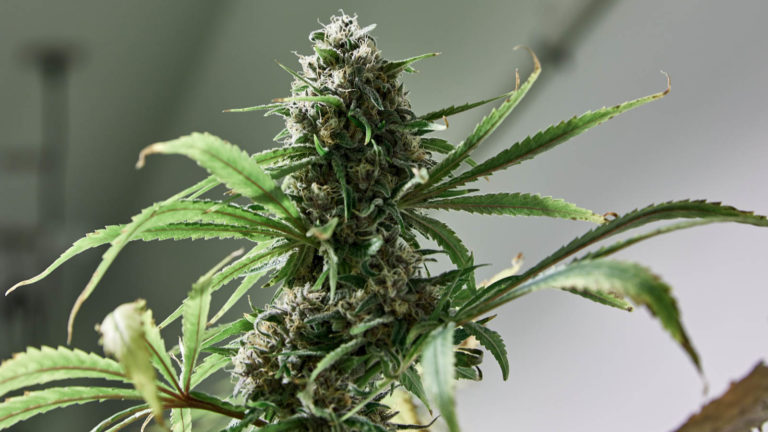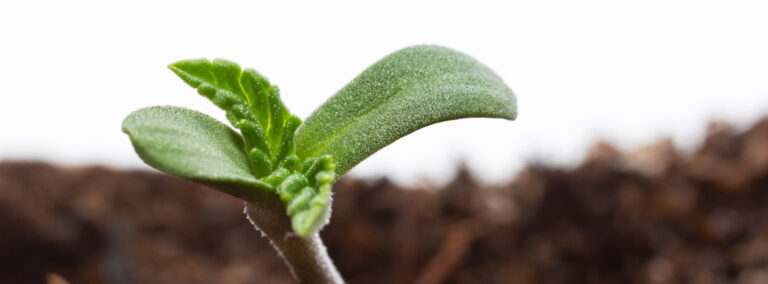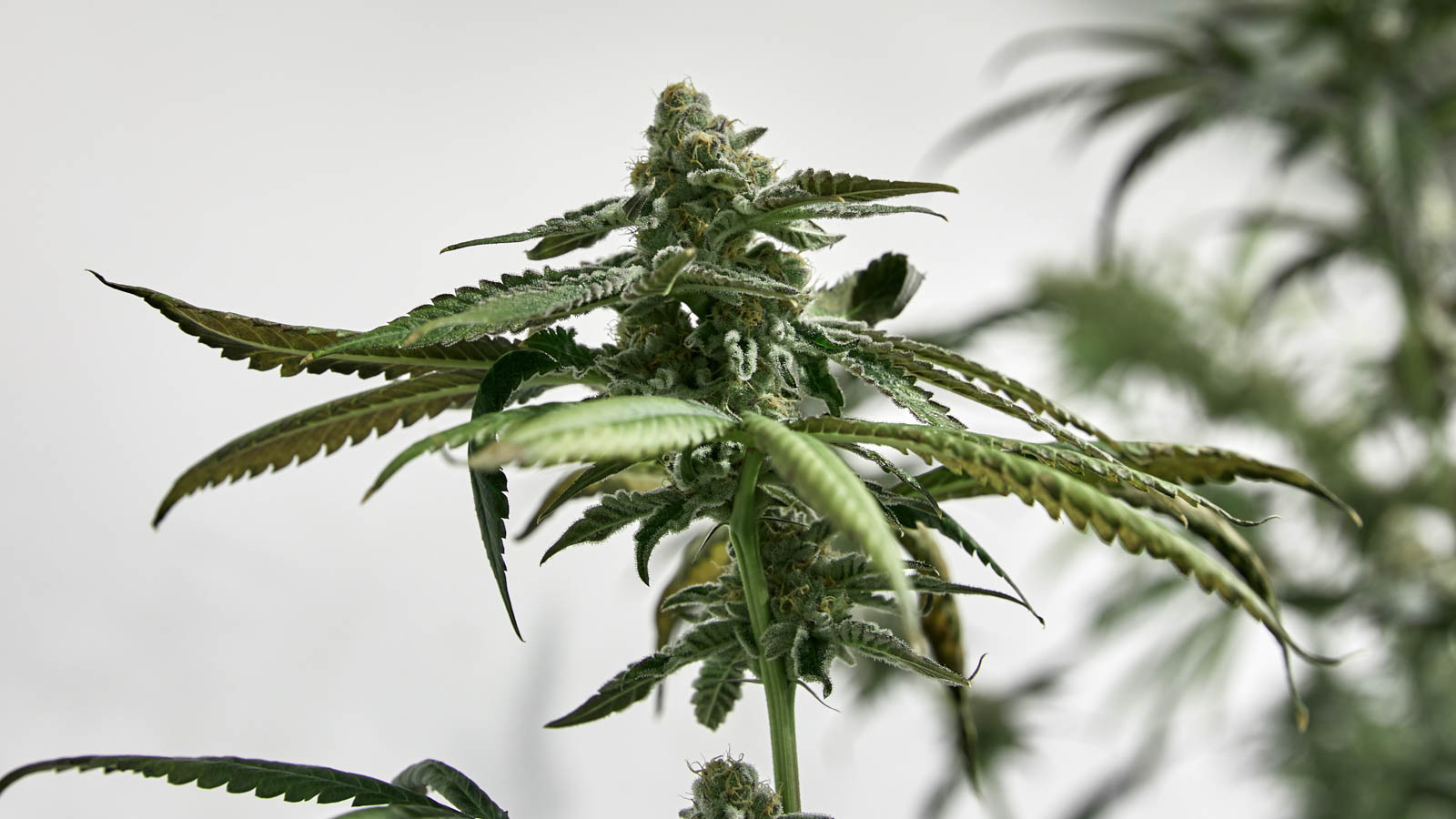The central flower cluster that forms along the upper portion of the main stems and large branches in a mature female cannabis plant. Colas are composed of tightly woven teardrop-shaped buds that can grow upwards of 24 inches when grown in a greenhouse setting. They are a prized possession among growers and consumers due to the high concentration of active resin, as well as for their photogenic qualities due to their size and luster.
That Northern Lights cola was the size of my whole forearm!
I couldn't pass up on buying that quarter-ounce cola even though I knew it probably had a 3-gram stem in it. It just looked so good.
The anatomy of a cola
An untrained female cannabis plant will typically reach the flowering phase with most of her growth focused upward in one central stem that has minimal branching toward the top, giving it an overall pear shape. A trained female plant will enter the flowering phase with multiple budding sites that will encourage the growth of many equal-size colas throughout the plant.
On an untrained plant, the distance between nodes, the intersection on the main stem where leaves and branches sprout off, is smaller toward the top of the plant, giving the top of the main stem a crowded appearance with a lot of small branches and leaves. As flowers begin to grow and mature, the untrained cannabis plant will concentrate the majority of its metabolic energy towards the top of the plant and produce one large cola with many smaller buds below.
 Photo by: Gina Coleman/Weedmaps
Photo by: Gina Coleman/WeedmapsImage lightbox

Ripening flowers that grow on these clustered nodes grow into one another, which gives the entire upper third of the plant the appearance it is one giant bud. Despite what it seems, the cola is made up of many small trichome-rich buds that have matured along the upper stem, and are surrounded with many sugar leaves that are also coated in trichomes. Breaking a bud off the middle of the cola reveals the central stem that holds the whole plant structure together. Because colas have a large stem in the middle, astute cannabis purchasers often shy away from purchasing colas to avoid paying for a stem.
Cultivators often use training techniques during the vegetative stage to encourage the growth of multiple budding sites and discourage the growth of one single cola. When these plants are moved into the flowering phase, the larger branches develop colas, and the term main cola is sometimes used to differentiate between these two. Pruning and trellising offer distinct advantages of spatial efficiency and uniform light delivery, and have become ubiquitous in indoor and outdoor cannabis cultivation. Pruning and training techniques such as trellising, Screen of Green (SCROG), Sea of Green, and others all strive to more even growth between the main stem and the branches. This produces colas that are generally shorter and less bulky.
Buds from the top of the cola are often reported to have higher cannabinoid content than those near the bottom. The hypothesis is based on differences in light intensity, which not only impact plant growth, but also potential cannabinoid production. However, pruning a plant to assure even light distribution may theoretically reduce the disparity in THC levels between flowers from the main stem versus branches.
How is the cola produced?
The growth of the cola follows the formation of flowers on the cannabis plant -- the cola is simply a large cluster of buds. However, authoritative usage of the associated botanical terms is useful for connoisseurs, budtenders, and cultivators alike.
As the cannabis plant steps out of its seedling stage, the leaves it sprouts go from having three fingers, to five, to seven. Taller, thin-leaf sativas can sprout nine fingers as they grow. Nearing the end of the plant's vegetative cycle, leaves begin to go back to five and then three near the top of the plant. Branching is also minimal at the end of the cannabis plant's vegetative cycle. Fewer leaves near the top provide more room for flower growth, allowing them direct view of sunlight.
 Photo by: Gina Coleman/Weedmaps
Photo by: Gina Coleman/WeedmapsImage lightbox

In more technical terms, seed germination precedes the emergence of two cotyledon leaves at the first node. This node sprouts a set of two more leaves from a second node growing perpendicular to the cotyledons. The stem between these two lengthens, and another set of leaves grow from the following node perpendicular to the last, and so on. The first set of leaves that grow after the cotyledons have characteristic serrated edges of cannabis leaves, but their leaf arrangement, or phyllotaxy, consists of only one leaflet (finger). The second set of leaves grows three leaflets, the third grows five, to seven, and even nine during the most intense phase of vegetative growth. Phyllotaxy changes again as the plant approximates its maximum height; leaflet count and leaf size decreases and branch length decreases significantly in the upper third of the main stem.
The decussate phyllotaxic arrangement (i.e., symmetrical leaf growth at each node) in some cases may change to an alternate phyllotaxic arrangement as the flowering cycle approaches in the later summer. Alternate phyllotaxy means only one leaf grows at each node, instead of two, and occurs at the top third of the plant where the cola grows.
The beginning of the flowering cycle is marked by the formation of primordial flowers at each node. These start out undifferentiated between female and male, but females quickly develop bracts and calyxes at the nodes behind the stipule at the intersection of the petiole and the main stem. In the first five weeks of flowering many more bracts and pistils emerge at each node, and the cola begins to take shape as a cluster of cannabis flowers that is abundant in white pistils from top to bottom giving it a hairy appearance. In the last three weeks of flowering, the bracts swell while pistils shrink and go brown. Mature cannabis plants often sag to one side due to the increase in weight from swollen, resinous trichomes that coat every part of the cola's anatomy. Growers use trellising to prop up the main cola and the smaller colas on the lower branches.
Sources:
Cervantes, J. (2015) The Cannabis Encyclopedia. Vancouver, WA: Van Patten Publishing.
Clarke, R. C. (1981) Marijuana Botany. Oakland, CA: Ronin Publishing.
Mahlberg, P. G. & Kemphill, J. K. (1983). Effect of Light Quality on Cannabinoid Content of Cannabis Sativa L. (Cannabaceae). Bot. Gaz. 144, 43-8.

